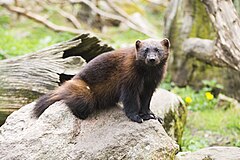Rosomak
| Gulo[1] | |||
| Pallas, 1780[2] | |||
 Przedstawiciel rodzaju – rosomak tundrowy (G. gulo) | |||
| Systematyka | |||
| Domena | |||
|---|---|---|---|
| Królestwo | |||
| Typ | |||
| Podtyp | |||
| Gromada | |||
| Podgromada | |||
| Rząd | |||
| Podrząd | |||
| Infrarząd | |||
| Parvordo | |||
| Rodzina | |||
| Podrodzina | |||
| Rodzaj | rosomak | ||
| Typ nomenklatoryczny | |||
Gulo sibiricus Pallas, 1780 (= Mustela gulo Linnaeus, 1758) | |||
| Synonimy | |||
| Gatunki | |||
| |||
Rosomak[5] (Gulo) – rodzaj ssaka z podrodziny Martinae w obrębie rodziny łasicowatych (Mustelidae).
Zasięg występowania
Rodzaj obejmuje jeden żyjący współcześnie gatunek występujący w Eurazji i Ameryce Północnej[6][7][8].
Morfologia
Długość ciała (bez ogona) 65–105 cm, długość ogona 21–26 cm; masa ciała samic 6–12 kg, samców 11–18 kg[7].
Systematyka
Etymologia
Gulo: łac. gulo, gulonis „żarłok”, od gula „obżarstwo, apetyt”[9].
Podział systematyczny
Do rodzaju należy jeden występujący współcześnie gatunek[6][5]:
- Gulo gulo (Linnaeus, 1758) – rosomak tundrowy
oraz gatunki wymarłe[10]:
- Gulo diaphorus Kaup, 1833
- Gulo primigenius Roth & Wagner, 1854
- Gulo sudorus Samuels, Bredehoeft & Wallace, 2018
Uwagi
Przypisy
- ↑ Gulo, [w:] Integrated Taxonomic Information System [online] (ang.).
- ↑ P.S. Pallas: Spicilegia zoologica: quibus novae imprimis et obscurae animalium species iconibus, descriptionibus atque commentariis illustrantur. Cz. 14. Berolini: Prostant apud Gottl. August. Lange, 1780, s. 25. (łac.).
- ↑ F. Hemming. Opinion 258. Rejection for nomenclatorial Purposes of the work by Frisch (J. L.) published in 1775 under the title Das Natur-system der Vierfüssigen Thiere. „Opinions and declarations rendered by the International Commission on Zoological Nomenclature”. 5, s. 55–72, 1954. (ang.).
- ↑ J.L. Frisch: Das Natur-System der Vierfüßigen Thiere. Glogau: Christian Friedrich Günther, 1775, s. 17. (niem.).
- ↑ a b Nazwy zwyczajowe za: W. Cichocki, A. Ważna, J. Cichocki, E. Rajska-Jurgiel, A. Jasiński & W. Bogdanowicz: Polskie nazewnictwo ssaków świata. Warszawa: Muzeum i Instytut Zoologii PAN, 2015, s. 156. ISBN 978-83-88147-15-9. (pol. • ang.).
- ↑ a b C.J. Burgin, D.E. Wilson, R.A. Mittermeier, A.B. Rylands, T.E. Lacher & W. Sechrest: Illustrated Checklist of the Mammals of the World. Cz. 2: Eulipotyphla to Carnivora. Barcelona: Lynx Edicions, 2020, s. 450. ISBN 978-84-16728-35-0. (ang.).
- ↑ a b S. Larivière & A.P. Jennings: Family Mustelidae (Weasels and relatives). W: D.E. Wilson & R.A. Mittermeier (red. red.): Handbook of the Mammals of the World. Cz. 1: Carnivores. Barcelona: Lynx Edicions, 2009, s. 627–628. ISBN 978-84-96553-49-1. (ang.).
- ↑ D.E. Wilson & D.M. Reeder (red. red.): Genus Gulo. [w:] Mammal Species of the World. A Taxonomic and Geographic Reference (Wyd. 3) [on-line]. Johns Hopkins University Press, 2005. [dostęp 2021-05-23].
- ↑ T.S. Palmer. Index Generum Mammalium: a List of the Genera and Families of Mammals. „North American Fauna”. 23, s. 303, 1904. (ang.).
- ↑ Classification of the genus Gulo. Fossilworks: The Paleobiology Database. [dostęp 2021-05-23]. (ang.).
Media użyte na tej stronie
Autor: (of code) -xfi-, Licencja: CC BY-SA 3.0
The Wikispecies logo created by Zephram Stark based on a concept design by Jeremykemp.
Autor: Jonathan Othén, Licencja: CC BY-SA 4.0
Wolverine in Sweden during spring time

